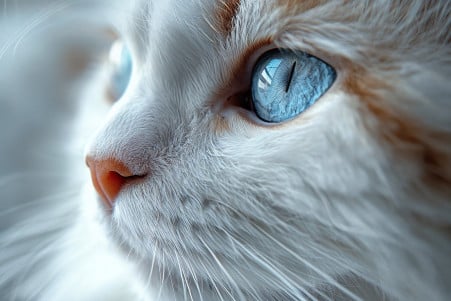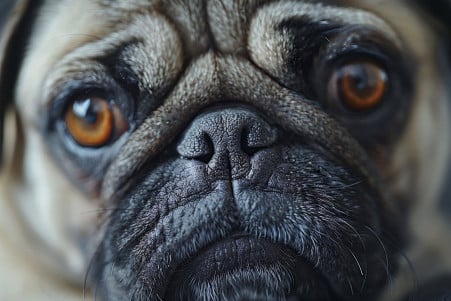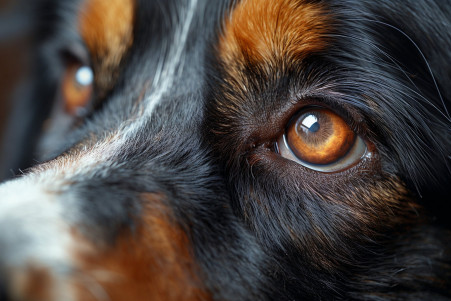Why Do Dogs Have Eyelashes? Evolution and Eye Health
25 April 2024 • Updated 24 April 2024

If you've ever looked into your dog's eyes, you've probably noticed that, despite their furry faces, they have eyelashes. But what are the purpose and characteristics of a dog's eyelashes? Dogs do have eyelashes, but they are much finer and less noticeable than those of humans. They still, however, protect the eyes from dirt and debris, help with tear production to keep the eyes moist, and offer some protection from the sun.
While they may not be the first thing you notice when you look at a dog's face, eyelashes are still important for the health and well-being of a dog's eyes and vision. To help you understand this part of a dog's anatomy, we'll look at the scientific studies and expert opinions about the evolutionary purpose, development, and common issues associated with dog eyelashes. By the end, you'll have a better understanding of and respect for your dog's eyes and the tiny hairs that help protect them.
Do dogs have eyelashes?
The Anatomy of a Dog's Eye and the Role of Eyelashes
The anatomy of a dog's eye is actually quite similar to that of a human eye. According to PetMD, the basic components of the eye include the sclera (the white of the eye), the cornea (the clear outer layer of the eye), the iris (the colored part of the eye that controls the size of the pupil), the pupil (the adjustable opening that lets light in), the lens (which focuses light on the retina), and the retina (which contains the light-sensitive rods and cones).
However, there are also some important differences in dog eye anatomy. The tapetum lucidum is a layer of tissue that reflects light and helps dogs see in the dark. The nictitating membrane or "third eyelid" is a white or pinkish membrane that helps protect the eye and spread tears over the eye's surface.
While dogs don't have the long, thick eyelashes that humans do, they do have very short eyelashes on their upper eyelids. These eyelashes help protect the eyes by keeping out debris, help with tear production by stimulating the lacrimal gland, and provide some protection from bright light, just like human eyelashes. However, Zigzag notes that dogs don't have eyelashes on their lower eyelids.
Dogs' vision is also different from humans' vision. While humans have high-resolution color vision, dogs have low-resolution color vision. According to PetMD, this means that dogs are nearsighted and have lower visual acuity, see fewer colors, but have better night vision and motion detection because they have more rods in their retinas. Their short eyelashes help support these differences in vision.
Eyelash Disorders and Abnormalities in Dogs
There are several different types of eyelash disorders that can affect dogs, including distichiasis, ectopic cilia, and trichiasis. Distichiasis is the most common of these disorders and occurs when eyelashes grow in an abnormal location, specifically from the eyelid margin instead of the skin of the eyelid. Davies Veterinary Specialists notes that in many dogs the hairs are soft and cause no problem, but in some cases they can irritate the eye and even damage the cornea.
Ectopic cilia is another type of abnormal hair growth, but in this case, the hairs grow through the conjunctiva on the inside of the eyelid and make direct contact with the cornea. WagWalking says that ectopic cilia are most common in young dogs, are very painful, and often lead to corneal ulcers. Trichiasis is a condition in which normal eyelashes grow in the wrong direction and rub against the eye.
These disorders are often hereditary, and certain breeds, including the American Cocker, Bulldog, Cocker Spaniel, and Shih Tzu, are more likely to be affected. The Animal Eye Clinic notes that the presence of abnormal eyelashes can cause clinical signs such as squinting, tearing, and eye irritation, and if they aren't treated, they can cause corneal wounds, scarring, and blindness.
Thankfully, there are treatment options for these disorders, including the use of lubricants, surgical removal of abnormal follicles, and cryotherapy to permanently destroy the abnormal hairs. However, it's important to get veterinary care as soon as possible to treat eyelash disorders and prevent damage to a dog's eyes.
Breed Differences: Breeds Prone to Ectopic or Distichiasis
Some breeds are more prone to ectopic or distichiasis than others. According to SanSaw Kennels, the Cocker Spaniel, Curly Coated Retriever, English (British) Bulldog, Golden Retriever, and Shetland Sheepdog are more likely to have eyelash disorders like distichiasis, ectopic cilia, and trichiasis.
These disorders are often hereditary, and PetHealth Network notes that the shape and deformities of the face can make the disorders more likely. This is especially true for the Pekingese, Shih Tzu, Lhasa Apso, and Cavalier King Charles Spaniel.
The University of Prince Edward Island says that the mode of inheritance for these eyelash disorders is not well-defined, but they are prevalent in these breeds due to selective breeding and genetic predispositions. It's important for these dogs' owners to stay on top of grooming and make sure their dogs are seen by a vet regularly to catch and treat any eyelash-related issues early.
Dog vs. Human Eyelashes: Anatomy and Purpose
Although dogs and humans have similar eye structures, there are some key differences between dog and human eyelashes. According to research by Washington State University, dogs have 2-4 rows of eyelashes on their upper eyelids, while humans have just one row. On the other hand, dogs don't have any eyelashes on their lower eyelids.
In addition to these differences, dog eyelashes are also structurally different from human eyelashes. According to information on Stefischer.de, dog eyelashes are much thinner than human eyelashes, with diameters between 1-10 microns, while human eyelashes are much thicker. This difference in size and density may be an evolutionary adaptation, as the same source notes that most animal eyelashes are about one-third the width of the eye itself, which is the perfect length to protect the eye effectively.
In addition to using their eyelashes to protect their eyes from debris and help with tear production, dogs have a third eyelid called the nictitating membrane that helps protect and lubricate their eyes. This extra layer of protection is an advantage that humans don't have. Knowing about these differences in anatomy and purpose can help dog owners understand the important role their pet's eyelashes play in their eyes' health and function.
Other Purposes: What Dog Eyelashes Do
In addition to protecting the eyes, dog eyelashes have several other purposes that help support a dog's eye health and quality of life. Winston and Porter note that dogs have a third eyelid, the nictitating membrane, that works with their eyelashes to protect and maintain the health of their eyes. This membrane helps produce tears that keep the eye moist and clean, which helps protect the eye from dirt, dust, and other irritants.
Eyelashes may also help dogs with their field of vision and peripheral awareness. Studies have shown that while dog eyelashes are shorter and less noticeable than human eyelashes, they help protect the eyes from bright light and peripheral distractions, which in turn helps dogs see more clearly.
Eyelashes also help keep dogs' eyes healthy by protecting them from infections and irritations. The NIH explains that the way dog eyelashes are arranged and the way they work with the nictitating membrane helps keep dust and debris from entering the eye, which helps prevent corneal abrasions and other problems.
In the end, these other purposes of dog eyelashes help dogs better adapt to and live in their environments. By protecting the eyes, helping produce tears, and improving visual acuity, dog eyelashes are important for dogs' overall health and well-being.
Conclusion: Why Dog Eyelashes Matter and the Impact on Eye Health
Dog breeds have a wide variety of eyelash characteristics, from those with long, thick, and luxurious lashes to those with short, sparse, and barely noticeable lashes. While Dogster says all dogs have eyelashes, the length and thickness of the lashes can vary greatly. Smaller breeds tend to have shorter and less dense lashes because their eyes are smaller and need less protection from debris.
Some breeds, like Poodles and Australian Shepherds, are known for their longer, thicker lashes, which are often considered more attractive. However, the Merck Veterinary Manual says the length of a dog's eyelashes doesn't necessarily impact their eye health or how well their lashes protect their eyes. In some cases, long eyelashes can cause irritation and lead to problems like corneal ulcers.
Some dogs, especially those with certain facial structures or genetic predispositions, are more likely to develop eyelash disorders like distichiasis, where the lashes grow in the wrong direction and rub against the eye. According to PetMD, breeds like Cocker Spaniels, Retrievers, and Bulldogs are more likely to develop these types of eyelash disorders. It's important for these breeds to be groomed and seen by a vet regularly to catch and treat any eyelash-related issues.
Understanding the importance of dog eyelashes and making sure to address any issues related to them through regular grooming and veterinary care can help ensure dogs' long-term vision and comfort.


